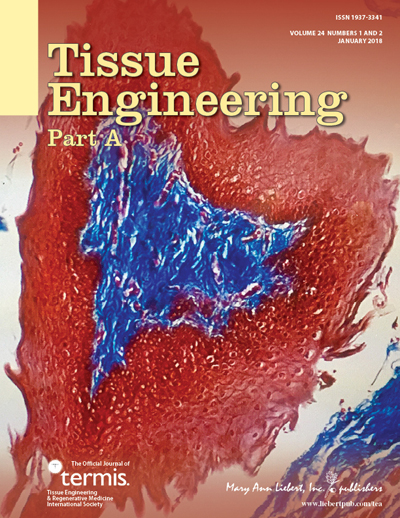For Immediate Release
Heparan Sulfate Biomaterials Retain Structure and Function after Gamma Irradiation
Contact: Kathryn Ryan
914-740-2250
kryan@liebertpub.com

New Rochelle, NY, January 25,2018—A new study has shown that heparan sulfate, a desirable natural material for use in bioengineered tissues and orthotic implants, can withstand the stress of gamma irradiation for sterilization and retain its structure, binding ability, and biological function. The ability to use a low-cost sterilization method such as gamma irradiation will make heparan sulfate-based biopolymers more broadly applicable for treating a range of disorders, as described in an article published in Tissue Engineering, Part A, peer-reviewed journal from Mary Ann Liebert, Inc., publishers. The article is available free on the Tissue Engineering website until February 25, 2018.
The article entitled "Retention of the Structure and Function of Heparan Sulfate Biomaterials After Gamma Irradiation" is coauthored by Simon Cool, PhD, Institute of Medical Biology, Singapore and Yong Loo Lin School of Medicine, National University of Singapore and colleagues from these institutions as well as Victoria University of Wellington, New Zealand and Lee Kong Chian School of Medicine, Singapore. The researchers examined the effects of gamma irradiation on a form of heparan sulfate that enhances the effects of bone morphogenetic protein 2 (BMP2) to stimulate bone growth. They demonstrated that irradiation did not significantly affect HS3's ability to enhance the osteogenic effects of BMP2 on mouse myoblasts in the laboratory. Gamma irradiation also did not significantly reduce calcium deposition.
"This article exemplifies the need to characterize the effects of sterilization on the structure and function of biopolymers before their use in tissue engineering applications," says Tissue Engineering Co-Editor-in-Chief Antonios G. Mikos, PhD, Louis Calder Professor at Rice University, Houston, TX.
Research reported in this publication was supported by the National Institutes of Health under Award Numbers1R01EB020367 and 1P41EB021911. The content is solely the responsibility of the authors and does not necessarily represent the official views of the National Institutes of Health.
About the Journal
Tissue Engineering is an authoritative peer-reviewed journal published monthly online and in print in three parts: Part A, the flagship journal published 24 times per year; Part B: Reviews, published bimonthly, and Part C: Methods, published 12 times per year. Led by Co-Editors-in-Chief Antonios G. Mikos, PhD, Louis Calder Professor at Rice University, Houston, TX, and John P. Fisher, PhD, Fischell Family Distinguished Professor & Department Chair, and Director of the NIH Center for Engineering Complex Tissues at the University of Maryland, the Journal brings together scientific and medical experts in the fields of biomedical engineering, material science, molecular and cellular biology, and genetic engineering. Leadership of Tissue Engineering Parts B (Reviews) and Part C (Methods) is provided by Katja Schenke-Layland, PhD, Eberhard Karls University, Tübingen and John A. Jansen, DDS, PhD, Radboud University, respectively. Complete tables of content and a sample issue may be viewed online at the Tissue Engineering website. Tissue Engineering is the official journal of the Tissue Engineering & Regenerative Medicine International Society (TERMIS). Complete tables of content and a sample issue may be viewed on the Tissue Engineering website.
About the Publisher
Mary Ann Liebert, Inc., publishers is a privately held, fully integrated media company known for establishing authoritative peer-reviewed journals in many promising areas of science and biomedical research, including Stem Cells and Development, Human Gene Therapy, and Advances in Wound Care. Its biotechnology trade magazine, GEN (Genetic Engineering & Biotechnology News), was the first in its field and is today the industry’s most widely read publication worldwide. A complete list of the firm’s 80 journals, books, and newsmagazines is available on the Mary Ann Liebert, Inc., publishers website.